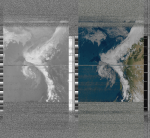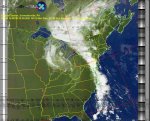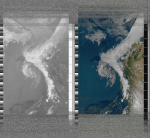I bought a USB-RTL and can pick up radio stations and can see the signal transmitted from my gate opener.
I originally setup RTL-Sharp, WXtoimg, and orbitron with the pluing in orbitron to control the channel with doppler shift. When a NOAA 15 or 18 go over I can hear a signal but it is weak and I get a almost viewable image. I have made a youtube video showing my setup (I test outside but the video is inside to make it easier to see)
antenna Setup
Retry with SDR-Console and WXtoImg on a nother night. You can see the signal but it appears to be -40db is that kind of weak?
I tried again the other night with SDr-Console and WXtoImg.
Do you see anything wrong with my Antenna? Does the signal look weak? Any other ideas?
I know the satellite is at the right spot because I installed a app on my phone that shows the location and the signal gets stronger when I point it towards it.
At this location it looks like it is decoding but it isn't clear. It just shows this:

I originally setup RTL-Sharp, WXtoimg, and orbitron with the pluing in orbitron to control the channel with doppler shift. When a NOAA 15 or 18 go over I can hear a signal but it is weak and I get a almost viewable image. I have made a youtube video showing my setup (I test outside but the video is inside to make it easier to see)
antenna Setup
Retry with SDR-Console and WXtoImg on a nother night. You can see the signal but it appears to be -40db is that kind of weak?
I tried again the other night with SDr-Console and WXtoImg.
Do you see anything wrong with my Antenna? Does the signal look weak? Any other ideas?
I know the satellite is at the right spot because I installed a app on my phone that shows the location and the signal gets stronger when I point it towards it.
At this location it looks like it is decoding but it isn't clear. It just shows this:









